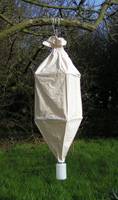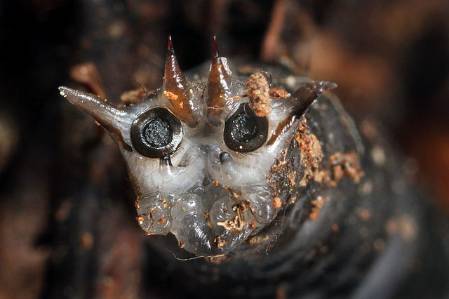Well the one good thing about the weather being so awful is that is has forced me to be desk bound and so I am finally getting round to sorting material from previous field trips (both mine and other material that has been donated). This has been both dry material that has been pinned and wet samples that have been collected some way or another into alcohol. There is nothing quite like the smell of stale alcohol on your fingers...
One of the projects with loads of material is in collaboration with the soil biodiversity group within the Museum and their volunteers (we love our volunteers!). The NHM have been sampling in the New Forest for many years now collecting soil surface invertebrates from Winkler bags.
Image from http://entomology.org.uk/products.htm
Material, such as leaves, is placed inside the trap and the insects etc gradually fall down into the collecting pot below. It is a passive way of sampling for insects and you can collect from a known area so make very good cross site comparisons. However, from the samples, certain groups were ignored, deemed too difficult for non specialists to deal with. This is hopefully were team Diptera come in! We are trying to develop a simple key for New Forest Diptera larvae to enable the team of volunteers to be able to go through these groups.
The larvae are important as they contribute much to the break down of leaves and therefore nutrient recycling. However, there are huge gaps in our knowledge of fly larvae – the Dipterists Forum state ‘at present it almost seems that most adult flies arise by spontaneous generation, as was commonly believed two or three hundred years ago!’ because of this lack of knowledge!!
Nigel Wyatt, resident specialist in all things maggoty spent some time last week teaching the rest of us lesser mortals the finer details of identifying specimens with limited features:
Kim, Nigel, myself and new recruit Duncan.
Although this is not the clearest of photos it does show us all happy. This is because Nigel was here to help us. When he left we fell apart and struggled to identify anything further!!!!! Ho hum...
However there are a few that are just very bizarre…
http://www.flickr.com/photos/myriorama/5477081059/in/faves-pcoin/
What is not obvious about the above image is that is it's posterior end of a crane fly larvae ... I will not say anything more on the subject on the grounds of public decency ...
But the tears will hopefully be worth it. This project is part of a much wider one trying to develop a larval collection for British Diptera as there are limited such collections, except with the aquatic larvae (but even then it is not exhaustive). In doing so we have been routing around the main spirit collection to see where there is any room - the problem with doing this though is that I tend to get myself side-tracked by other jars of really interesting specimens.
The spirit collection is jars in trays on shelves in cabinets looking suspiciously like this….
The samples shown here are from various trapping events from the past that still need to be sorted. We have several cabinets and know that we are probably sitting on much undescribed material.
However, below these traps were some random jars. Check out these wonders:
A lovely jar of bot fly larvae - what more could a girl ask for?
Or what about this one:
Please excuse the blurred picture but I was probably over excited at the time with my finds. These are some more flies with the very small eggs at the bottom, on top of them are the larvae and then the top layer is the adults - granular convection before your very eyes (the brazil nut effect where the large nuts always end up at the top).
So a picklers life for us for a while trying to sort this all out








